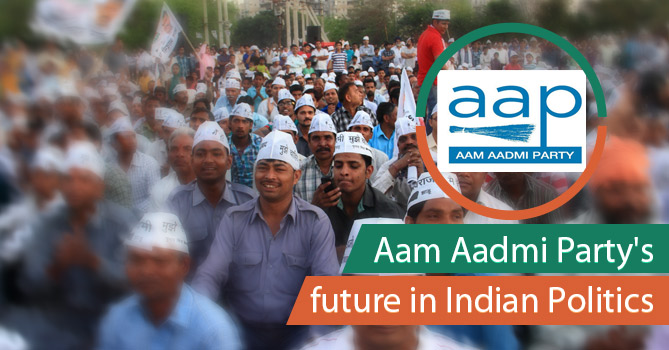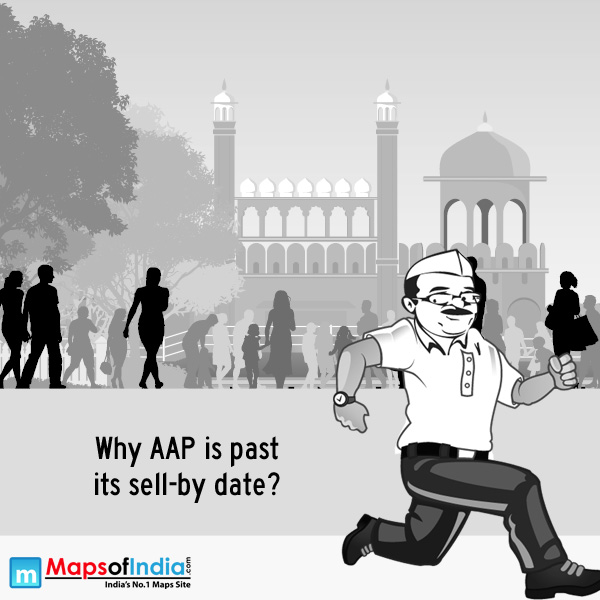It has been nearly 6 years when Aam Aadmi Party was carved out of India Against Corruption movement in 2012, as Arvind Kejriwal and several other members of IAC felt that the movement won’t serve the purpose until there is a direct involvement in the politics. Thus, AAP embarked on the trodden path of Indian politics, Anna Hazare who was against the formation of the party became a staunch critic of the party, while many labelled them as the second-hand of Congress. The AAP’s first taste of politics came during the 2013 Delhi Legislative Assembly election. The party emerged as the second largest party with 29 seats and formed the government with conditional support from Congress, but the government was brought down within 49 days. Since then, AAP has been on a roller-coaster ride from securing four seats in the 2014 General Assembly elections, sweeping away in the 2015 Delhi Assembly elections with 67 seats in the house of 70 to tasting defeats in several state assembly elections.
The start of AAP’s political journey
In 2011, Anna Hazare and Arvind Kejriwal along with several prominent civil society members started a pan-India movement that came to be known as India Against Corruption. The movement against the prevalent corruption in India and the introduction of Jan Lokpal bill steadily gathered momentum. Jantar Mantar in Delhi became the epicentre, where thousands of people from all walks of life joined the protest led by Anna Hazare. The anti-corruption movement forced the government to take immediate measures to introduce the Jan Lokpal bill in the Parliament to call-off the protest but nothing materialised. Anna Hazare felt that the movement should continue while Arvind Kejriwal felt that in order to fight corruption it is necessary to take the political route by being directly involved. This internal strife became a bone of contention and led to factions within the core members of the movement, Arvind Kejriwal along with several members formed the Aam Aadmi Party and ventured into the murkier waters of Indian politics, while Anna Hazare continued with his movement that eventually faded after several key figures joined Arvind Kejriwal.
The electoral highs and lows
The 2013 Delhi Assembly election was Aam Aadmi Party’s first step in to the electoral politics. The party made a grand debut by winning 29 seats and forming the government with the conditional support from Indian National Congress. The euphoria did not last too long for AAP, as the government was dissolved in 49 days due to indifferences between the party and Congress. Next up for Kejriwal and co. was the 2014 General Assembly elections, where party was looking to be an alternative to Congress in the national stage. AAP was optimistic of being a formidable challenge to the “Modi Wave” that swept the majority in Lok Sabha and Kejriwal and his party could only secure four Lok Sabha seats. Arvind Kejriwal lost to BJP’s Prime Ministerial candidate Narendra Modi from Varanasi constituency.
In 2015, Delhi headed for fresh elections for the state assembly, this time around AAP emerged with a historic mandate by winning 67 seats out the 70 in Delhi Vidhan Sabha, the victory propelled the party as a viable face for opposition in the country. However, with an uneventful 2016, party shifted its focus on the 7 state assembly elections held in 2017. Aam Aadmi Party suffered huge setbacks as in majority of these states the party’s candidature lost their deposits as they failed to make any significant impact, except for the state of Punjab where the party emerged as the second largest party with 20 seats, way behind the Congress party and 2 seats ahead of the Shrimoni Akali Dal-BJP alliance. The party did fairly well in Uttar Pradesh Civic body elections by winning 44 seats and merged as the fifth largest party behind the Big 4 (BJP, Congress, SP, and BSP).
The year 2018 also started on a low note for the party as the party failed to cover up the ground in Karnataka, Tripura, Meghalaya, and Nagaland.
The way forward for AAP
With the 2019 General Assembly elections hardly a year away, several high profile states are set to head for assembly elections at the end of 2018. Aam Aadmi Party will be looking to gather a positive momentum to carry forward in what could be a make or break year for the party. AAP was a product of a high-profile anti-corruption campaign and a unique political experiment, the promise of ‘alternative politics’ was what appealed the supporters of the party.
The early electoral successes of the party was a result of the volunteer mobilisation where people from various age group joined the party to be a part of the change in India political landscape. However, with internal organisational strives and the banalisation of the party by the media has resulted in several core members leaving the party and party slowly losing its support base. If the party led by Arvind Kejriwal are to be a formidable force in not only the upcoming elections but in a long run, AAP needs to resolve all the internal issues that are plaguing the image of the party, while also focusing on mobilising volunteers and grass-root level organisational workforce.






